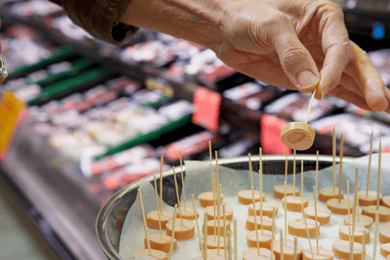
In the dynamic world of marketing, staying ahead is crucial. As 2024 begins, experiential marketing takes the cake, yet again, evolving to meet changing consumer...
Sensory marketing has altered how we communicate with our customers. You can use the power of sensory stimulation to create memorable, immersive experiences.
The science of sensory marketing will be looked at in this article, along with its benefits and real-world uses in experiential marketing campaigns.
We'll also go through a fascinating case study that demonstrates the success of sensory marketing strategies.
2. The Science Behind Sensory Marketing
3. Benefits of Using Sensory Marketing
4. Successful Sensory Marketing Case Study: Starbucks Reserve Roastery
5. Implementing Sensory Marketing in Experiential Campaigns
6. Ethical Considerations in Sensory Marketing
8. FAQs

To truly harness the power of sensory marketing in experiential campaigns, it is essential to understand the role of each of the five senses—sight, hearing, smell, taste, and touch—and how they can be strategically employed to create impactful and memorable brand experiences.
Let's explore each sense and its significance in marketing:
Visual stimuli play a vital role in shaping consumer perceptions and creating brand recognition.
Colors, shapes, images, and visual storytelling can evoke emotions, convey your brand messages, and captivate attention.
From vibrant packaging to captivating visuals in advertising and immersive visual displays, leveraging the power of sight can leave a lasting impression on consumers.
Sound has a profound impact on emotions and memory recall.
Incorporating auditory elements such as music, sound effects, jingles, and brand-specific sounds can evoke emotions, enhance your brand identity, and trigger brand associations.
Whether it's a catchy jingle or a soothing background melody, the right auditory cues can create a powerful and memorable brand experience.
The sense of smell is closely linked to emotions and memory.
Fragrances have the ability to transport individuals to specific moments and trigger nostalgic feelings.
You can infuse scent into your experiential campaigns by using ambient scents in physical spaces, scented product samples, or scented packaging.
By leveraging the power of smell, you can create a sensory journey that connects with consumers on a deeper level.

Tasting experiences can create strong emotional connections and lasting memories.
Through product sampling, food and beverage activations, or even sensory-inspired marketing events, you can engage consumers' taste buds to create positive associations and deepen brand loyalty.
The flavors, textures, and culinary experiences associated with your brand can leave a lasting impression that sets it apart from competitors.
The sense of touch can create a tangible and tactile experience for consumers.
By incorporating textures, materials, and interactive elements, you can stimulate the sense of touch to engage consumers.
From product packaging that feels luxurious to interactive displays that encourage tactile exploration, leveraging the sense of touch can enhance the overall brand experience and create a sense of connection.
By strategically combining these sensory elements, you can create multi-sensory experiences that engage multiple senses simultaneously, amplifying the impact and memorability of your experiential campaigns.
Integrating sight, hearing, smell, taste, and touch in a cohesive and harmonious way can evoke emotions, trigger memories, and forge strong connections with consumers.
Understanding the unique potential of each sense and tailoring sensory experiences to align with your brand values and target audience preferences can unlock the full potential of sensory marketing.
By engaging all five senses, you can create immersive and unforgettable experiences that leave a lasting imprint on consumers' minds and hearts.

To properly appreciate the potential of sensory marketing, you must completely understand the science behind it.
Marketers and the sector at large are becoming increasingly conscious of the important impact that our senses have on how we interact with and interpret the world around us.
Here's a closer look at the science behind sensory marketing:
All our senses—sight, hearing, taste, smell, and touch—are closely related to our feelings and memories.
Our brains process sensory stimuli to produce emotional reactions, such as the aroma of freshly made coffee or the sound of crashing waves.
These emotional reactions can be anything from happiness and excitement to consolation and melancholy.
Emotional events are more likely to be recalled and to have a more significant influence on how people make decisions, according to research.
Your brand may tap into these emotional connections by including sensory components in your marketing strategies.
This helps you to create experiences that connect with customers on a deep level and stick with them.
One fascinating aspect of sensory marketing is the concept of multisensory integration.
Our brains have the remarkable ability to combine information from multiple senses and form a unified perception of our environment.
This integration enhances our overall experience and can significantly influence how we interpret and remember brand interactions.
For example, when we enjoy a meal at a restaurant, it's not just the taste of the food that shapes our experience.
The ambiance, lighting, background music, and even the texture of the utensils all contribute to our perception of the meal.
By carefully crafting these multisensory elements, you can create cohesive and immersive experiences that engage multiple senses simultaneously, amplifying the impact of your marketing efforts.
Another fascinating aspect of sensory marketing is the concept of sensory priming.
This refers to the phenomenon where exposure to one sensory stimulus can influence our perception and response to subsequent stimuli.
For example, the sound of sizzling bacon can trigger associations with breakfast and evoke feelings of hunger and anticipation.
You can leverage sensory priming to shape consumer perceptions and behaviors.
By strategically using sensory cues that align with your brand identity and desired associations, you can create positive and memorable experiences.
These sensory associations can help build brand recognition, establish a unique brand personality, and even influence purchasing decisions.
Advancements in neuroscience and brain imaging techniques have provided valuable insights into the effects of sensory marketing on the brain.
Neuromarketing studies have shown that sensory stimuli can activate specific areas of the brain associated with emotions, memory, and decision-making.
For example, studies have revealed that visually appealing packaging and design elements can trigger the brain's reward centers, leading to positive associations with a brand and increased willingness to purchase.
Similarly, the scent of a particular fragrance can evoke specific emotions and memories, influencing consumer preferences and behaviors.
By understanding the neural responses triggered by sensory stimuli, you can optimize your marketing strategies to create more engaging and persuasive experiences that resonate with consumers on a subconscious level.
It's important to recognize that individuals have unique sensory preferences and sensitivities.
Factors such as culture, upbringing, and personal experiences can shape how individuals respond to sensory stimuli.
What may be appealing and effective for one person may not resonate with another.
Personalization plays a crucial role in sensory marketing.
By understanding your target audience and tailoring sensory experiences to align with their preferences, you can create highly personalized and meaningful interactions.
This level of personalization enhances the relevance and impact of sensory marketing efforts, fostering stronger connections with consumers.
Sensory marketing offers several benefits for brands looking to create impactful experiences:

By engaging multiple senses, you can create memorable experiences that leave a lasting imprint on consumers' minds.
This boosts brand recall and helps differentiate your brand from competitors in a crowded marketplace.
Sensory experiences can evoke emotions and forge deep connections with consumers.
When you tap into consumers' senses, it cultivates a sense of attachment and loyalty, leading to long-term relationships.
Sensory marketing encourages active engagement and participation from consumers.
By immersing them in multisensory experiences, you can create opportunities for meaningful interactions, driving higher engagement levels.
Sensory marketing influences how consumers perceive a brand.
When sensory cues align with your brand values and messaging, it enhances brand image, fosters positive associations, and shapes consumer perception.
Starbucks has mastered the art of sensory marketing with its Reserve Roastery concept.
The Roastery is a unique, immersive coffee experience where customers can witness the roasting process, engage with coffee masters, and indulge in the aromatic ambiance.
The combination of sights, sounds, smells, and tastes creates an unforgettable sensory journey for coffee enthusiasts.
The attention to detail in crafting the sensory elements aligns with Starbucks' commitment to delivering exceptional coffee experiences and elevates the brand in the minds of consumers.
To effectively implement sensory marketing in experiential campaigns, consider the following steps:
Understand your target audience's preferences, behaviors, and sensory triggers.
Tailor your sensory experiences to resonate with their unique characteristics and aspirations.
Develop cohesive and immersive experiences that engage multiple senses.
Consider the visual aesthetics, music, scent, textures, and even taste if applicable.
Ensure the sensory elements align with your brand identity and evoke the desired emotional response.

Maintain consistency across all touchpoints of the campaign to reinforce the sensory experience.
Ensure the sensory cues are authentic to your brand and align with your values, creating a seamless and genuine connection with consumers.
Track relevant metrics such as customer feedback, engagement levels, and brand perception to gauge the effectiveness of your sensory marketing strategies.
Continuously optimize your campaigns based on insights gathered to enhance the impact and ROI.
While leveraging sensory marketing, it's crucial to uphold ethical considerations:
Provide clear information about the sensory elements involved in your campaigns.
Obtain consent from participants before exposing them to sensory experiences to ensure a positive and respectful engagement.
Recognize that individuals may have varying sensory preferences and sensitivities.
Respect these preferences and avoid overwhelming or alienating consumers with excessive sensory stimuli.

Ensure that sensory experiences are inclusive and accessible to all individuals, considering factors such as disabilities, allergies, and cultural sensitivities.
Provide alternatives or adjustments to accommodate diverse needs.
Be mindful of the potential impact of sensory triggers, especially in sensitive or vulnerable populations.
Avoid exploiting emotions or manipulating consumers through sensory cues.
By incorporating these ethical considerations, you can create sensory marketing campaigns that respect and engage consumers while building positive brand experiences.
If you are trying to leave a lasting impression in the cutthroat market of today, sensory-driven experiential marketing efforts are becoming increasingly important.
You may engage customers on a deeper and more emotional level by appealing to their senses and creating immersive experiences.
We have discussed sensory marketing and its function in experiential campaigns throughout this article.
We've seen how sensory stimuli—such as images, sounds, smells, tastes, and tactile sensations—can evoke feelings, stir up memories, and influence how consumers perceive products.
From the Starbucks case study to the science behind sensory marketing, we have witnessed the effectiveness of incorporating sensory elements in marketing strategies.
The ability of sensory marketing to create lasting impressions, enhance brand recognition, and influence consumer behaviors is backed by scientific research and real-world success stories.

However, it's important to note that sensory marketing is not a one-size-fits-all approach.
You must consider your target audience, cultural nuances, and individual preferences to create personalized experiences that resonate deeply.
By understanding the science behind sensory perception, multisensory integration, sensory priming, and brain responses, you can optimize your marketing efforts to captivate your audience.
As technology continues to advance, there are even more exciting opportunities for sensory marketing. Virtual reality (VR), augmented reality (AR), and haptic technologies offer immersive and interactive experiences that can transport consumers to new dimensions.
Brands can leverage these emerging technologies to create even more memorable and engaging campaigns.
In conclusion, sensory marketing holds incredible power in experiential campaigns.
By appealing to multiple senses, you can create experiences that not only capture attention but also leave a lasting impact.
As the competition for consumer attention intensifies, embracing sensory marketing as part of an integrated marketing strategy can be the key to standing out, building strong brand connections, and driving business success.
So go ahead and use sensory marketing to its full potential in your experiential initiatives.
Engage your audience's senses, produce unforgettable moments, and watch as your brand ascends to the top of consumers' thoughts and hearts.
You can measure effectiveness through customer feedback, engagement metrics, brand perception surveys, and tracking key performance indicators associated with the campaign's objectives.
Ethical considerations ensure responsible and respectful implementation of sensory marketing, including transparency, respect for individual preferences, inclusivity, and avoiding manipulation or exploitation of consumers' emotions.
Yes, sensory marketing can be effective for online businesses as well.
While online experiences lack certain sensory elements like smell and touch, brands can still leverage visual and auditory cues to create immersive digital experiences.
Through engaging visuals, captivating videos, compelling storytelling, and even incorporating sound elements, online businesses can effectively utilize sensory marketing to connect with their audience.
No, sensory marketing can be applied across various industries.
While some industries like food, hospitality, and retail naturally lend themselves to sensory experiences, other industries can also benefit from incorporating sensory elements into their marketing strategies.
Whether it's through creative use of visuals, sound branding, experiential events, or even creating signature scents, any industry can leverage sensory marketing to engage customers and differentiate themselves in the market.

In the dynamic world of marketing, staying ahead is crucial. As 2024 begins, experiential marketing takes the cake, yet again, evolving to meet changing consumer...

In this article, we will look at how technology has changed experiential marketing campaigns, providing instances of its use, defining its benefits and drawbacks, and...